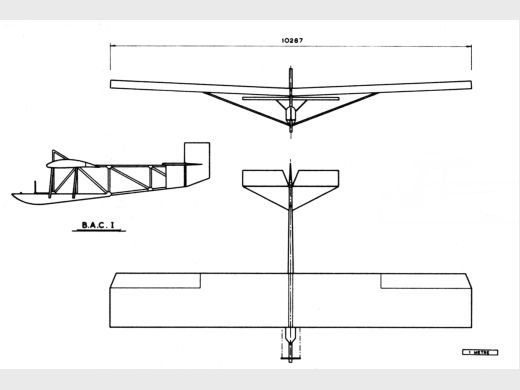
B.A.C. I
| DONNÉES GÉNÉRALES |
| Année du premier vol (ou de design, si seul projet) |
1930 |
| Pays | Angleterre |
| Designer(s) | LOWE-WYLDE, Charles H. |
| Premier constructeur | B.A.C. (British Aircraft Company, Maidstone) |
| Type d'appareil | Planeur |
| Fonction | Initiation |
| SPÉCIFICATIONS TECHNIQUES |
| Envergure | -- |
| Longueur | -- |
| Hauteur | -- |
| Allongement | -- |
| Surface alaire | -- |
| Profil aile | -- |
| Masse à vide | -- |
| Masse maxi | -- |
| Charge alaire | -- |
| Vitesse mini | -- |
| Vitesse maxi | -- |
| Finesse maxi | |
| Taux de chute mini | -- |
| Nb sièges | 1 |
| Structure | Bois et toile. |
AUTRES INFORMATIONS
| Constructeur(s) |
| ||||||
| Infos techniques | Fuselage poutre. | ||||||
| Histoire résumée | Charles H Lowe-Wylde was the first person in Britain to earn the F.A.I. "A" gliding certificate, on 30 March 1930, flying a primary glider of his own design, built in five weeks by members of the Kent Gliding Club and named "Columbus". The glider was first flown at Detling on 23 February 1930. Lowe-Wylde set up the British Aircraft Company in mid-1930, with works in an old brewery at Lower Stone Street, Maidstone. The first true B.A.C. aircraft was another primary, the B.A.C. I, again used by the Kent Gliding Club. Le planeur fut réquisitionnné par la R.A.F. pendant la Deuxième guerre mondiale avec le numéro NF746. En 1953, il volait encore sous le n° 162 GS, Hamsey Green. | ||||||
| Liens personnalités | Pas de personnalité associée. |
SOURCES DOCUMENTAIRES
| Liens WEB | Site : Wikipedia . British Aircraft Company. (2009-10-28 JM) |
| Livres | British Gliders and Sailplanes 1922-1970 par ELLISON, Norman (1971) [p. 34, 86, 243. Note + plan 3 vues]. |

Team J2mcL © 2003 -
- Pages optimisées pour Mozilla Firefox

